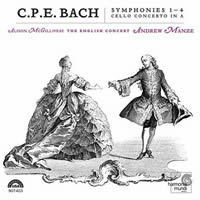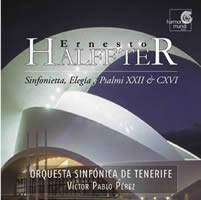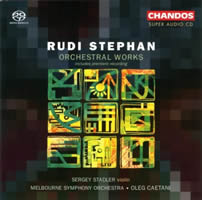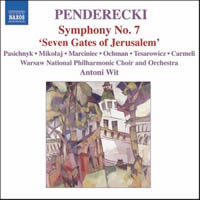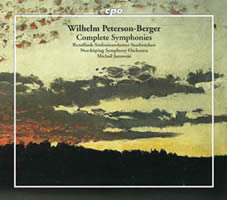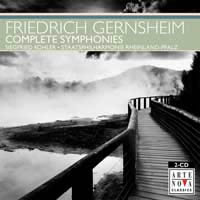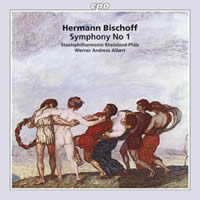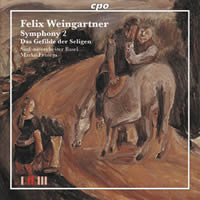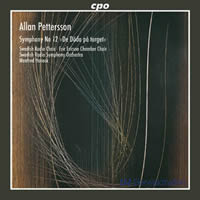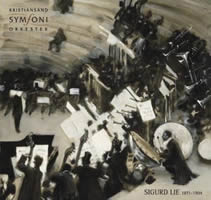Mostly Symphonies 4.
|
Grant Chu Covell [January 2007.]
Carl Philipp Emanuel BACH: 4 Orchestra Symphonies, Wq. 181 (1775?); Cello Concerto, Wq. 172 (1753?). Alison McGillivray (vlc); The English Concert, Andrew Manze (cond.). Harmonia Mundi HMU 907403. Distributed in the US by Harmonia Mundi (http://www.harmoniamundi.com/). Sturm und Drang is back. You read it here first. We’re teetering on a new age’s cusp guaranteed to perturb old-timers who survived the historically informed practice movement. Characterized by excessive friskiness, overarticulated and aggressive playing, this movement (perhaps we should call it “hysterically deformed?”) sacrifices intonation to boundless exuberance. Contrasts may be exaggerated to promote attentiveness. Minkowski’s recent Rameau disc exemplifies the phenom, and this C.P.E. Bach release falls nicely into line. Don’t get me wrong. I enjoy these nose-thumbing sessions, performed as if on a runaway carriage or tipsy on gin. Some may regard the infrequent glimmer of individual string voices as sloppiness, though this accurately reflects the energized exuberance of Manze’s solo efforts. Horns and harpsichord punch through in tart bursts. These symphonies are by nature erratic and thus well suited to jumpiness. The cello concerto receives a more conservative treatment, its central largo echoing the “Crucifixus” of Papa Bach’s B-Minor Mass. I’m fond of these four symphonies. Ages ago, I had a budget LP with misapplied labels, or perhaps the tracks were pressed out of order. Trying to reconcile why a specified andante was breakneck fast meant I listened over and over. Any day now, someone will realize there’s a whole batch of J.C. Bach and Haydn symphonies requiring similar rediscovery. Wouldn’t it be great if there were a whole category for this musical style? Oh wait — there already is.
Ernesto HALFFTER: Sinfonietta (1923-5, rev. 1927); Elegía (1966); Psalmi XXII (1967); Psalmi CXVI (1967). Ondrej Lewit (vln), Robert Pytel (vlc), Peter Jones (cbs); Coro polifónico de la Universidad de La Laguna, Carmen Cruz Simó (dir.); Susan Chilcott (sop), Claire Powell (mez-sop), Joan Cabero (ten), José Antonio Carril (bass); Orquesta Sinfónica de Tenerife, Víctor Pablo Pérez (cond.). Harmonia Mundi MHI 987067. Distributed in the US by Harmonia Mundi (http://www.harmoniamundi.com/). Harmonia Mundi captures a delightfully elegant turn at Halffter’s unfamiliar Sinfonietta. Neither serious nor slight, its four movements breathe the same neo-classical air as his teacher Falla’s 1926 harpsichord concerto. Imagine if Stravinsky had been a bit more joyful, a less compulsive polisher. Ethnic hat-tipping, such as in the “Minuetto,” is adeptly poised between romance and bucolic quaintness, nothing like Rodrigo’s touristy Concierto de Aranjuez (1939). The final movement wondrously cycles through diverse instrumental combinations. Pérez captures lightness and transparency, bettering hands down a clunky ASV release with the Orquesta Filarmónica de Gran Canaria under Adrian Leaper (ASV CD DCA 1078). This recording contributes greatly to the 20th-century symphonic tradition. Let’s hope Pérez is following up with some Falla. The disc continues with three choral works from Halffter’s mature phase wherein coy neo-classicism has gelled into a mysterious tonality, reflecting Halffter’s later teacher, Ravel. While we’re here, it would be wrong not to mention Halffter’s laborious (1957-76) completion of Falla’s grand Atlàntida (Auvidis Valois V 4685). Neither oratorio nor opera despite vocal soloists and choruses, this imposing canvas would have been Falla’s supreme achievement. Hardly neo-classical, it alternates somber and plush tonalities among restrained incorporation of folk material.
Rudi STEPHAN: Music for Violin and Orchestra (1911); Music for Orchestra (1910); Music for Orchestra (1912). Sergey Stadler (vln), Melbourne Symphony Orchestra, Oleg Caetani (cond.). Chandos CHSA 5040 (http://www.chandos.net/). Distributed in the US by Koch Entertainment Distribution (http://www.kochdistribution.com/). SACD format. If Stephan is unknown to you, blame the war: He was killed at Galicia during WWI, and Allied bombing destroyed his archives in WWII. In his short life (1887-1915), he deftly joined Mahler and Debussy’s language to create rich, sensuous compositions. More striking is his formal command, extending Brahms’ developing variations into a cyclic stream of consciousness. Stephan’s few works place him at the apex of Romantic composition, and yet, with his daring harmonies and structures, he probably would have become a formidable 20th-century figure. He was also among the first to employ abstract titles (“Music for …”). This disc premieres a forgotten piece, the 1910 Music for Orchestra, not to be confused with the 1912 eponymous work which cemented Stephan’s reputation. This earlier single-movement effort bewildered the premiering orchestra. At 24:30, its meandering flow marshals an epic sweep, far more succinct and fluid than any Strauss or Liszt tone poem. Compared to Schoenberg’s Five Pieces (written in 1909 though not premiered until 1912), Stephan is a romantic, yet his lissome structures make the future Zwolftonkunstler’s Pelléas look bloated. Zemlinsky and Szymanowski fans will find much to like in the Music for Violin and Orchestra and the 1912 Music for Orchestra, non-programmatic but strongly emotional works. Unlike Strauss’ extrovert music, Stephan’s art was inwardly focused, almost painfully so. The concluding bars of the 1912 Music ring unexpectedly false, as if Stephan got to a happy place he couldn’t wait to escape. Perhaps Freudian analysis would have helped. The quasi violin concerto hides a catchy idée fixe which becomes memorable as the work progresses. An aspiring fiddler would do well to program this obscure gem alongside the Korngold and Berg concertos. The 1911 and 1912 works were released on a 1984 Schwann CD (11623) alongside a setting of Friedrich Hebbel’s “Liebeszauber” for baritone and orchestra that sounds like a less ponderous Strauss Elektra (Hans Zender conducts the Radio-Symphonie-Orchester Berlin with Hans Maile, violin, and Dietrich Fischer-Dieskau). More than 20 years on, this SACD’s sonics are a distinct improvement, though Schwann captured DF-D in great form. Caetani takes both works slower: 19:56 (V&O) and 18:34 (O) vs. Zender’s 17:30 and 16:38.
Krzysztof PENDERECKI: Symphony No. 7, “Seven Gates of Jerusalem” (1996). Olga Pasichnyk, Aga Mikolaj (sops), Ewa Marciniec (alt), Wieslaw Ochman (ten), Romuald Tesarowicz (bass), Boris Carmeli (narr). Warsaw National Philharmonic Choir, Warsaw National Philharmonic Orchestra, Antoni Wit (cond.). Naxos 8.557766. Distributed in the US by Naxos (http://www.naxos.com/). I should be in the camp which prefers Penderecki’s early avant-garde phase to his latest neo-Romantic outpourings. Admittedly, there was a time and place for noise and aleatorics. Naxos 8.554491 provides a thumbnail sketch which groups the classic Threnody (1960) with Fluorescences (1961), De Natura Sonoris II (1971) and the retrenched, late-period Third (1988/95). While Threnody and Fluorescences can still surprise (like Satie’s Parade, Fluorescences requires a typewriter!), I suspect that Penderecki, like Rochberg, realized that atonality offered minimal expressive capabilities and that he had nowhere else to go. Penderecki’s religious beliefs are presumed the prime reason for his stylistic shift, yet I suspect Shostakovich’s influence an equal motivator. Commissioned to celebrate Jerusalem’s third millennium, the seven-movement Seventh corrals vocal soloists, chorus, narrator and orchestra. A grand, hour-long canvas, this oratorio swells and climbs, using seven-note themes and seven concluding chords. Penderecki’s palette reflects an awareness of Bach and Orff, with its amber tonality suggesting Szymanowski. The third movement is an a cappella De Profundis. A striking percussion timbre reminding one of the Blue Man Group emerges from the depths: Antiphonally placed tubaphones, thwacked resonant tubes (PVC pipes?) that splutter like loose marimbas.
Wilhelm PETERSON-BERGER: Complete Symphonies (5) & Orchestral Works. Ulf Wallin (vln), Rundfunk-Sinfonieorchester Saarbrücken, Norrköping Symphony Orchestra, Michail Jurowski (cond.). cpo 777 160-2, 5 CDs (http://www.cpo.de/). Distributed in the US by Naxos (http://www.naxos.com/). Friedrich GERNSHEIM: Complete Symphonies (4). Staatsphilharmonie Rheinland-Pfalz, Siegfried Köhler (cond.). Arte Nova ANO 636350 (http://www.allegro-music.com/artenova/). Distributed in the US by Allegro (http://www.allegro-music.com/). 2CDs. Cpo neatly repackages five discs containing the overlooked Peterson-Berger’s complete symphonies. If it’s genial Romantic fare you seek, look no further. Influenced by Wagner, yet predisposed to succinct, tuneful miniatures, Peterson-Berger’s symphonies (1903, 1910, 1915, 1929, 1933) ignored contemporary trends. Known as an especially opinionated music critic (Joachim protégé Willy Burmester refused to perform in his presence), Peterson-Berger (1867-1942) is in no way Sweden’s answer to Finland’s Sibelius or Denmark’s Nielsen, even though many nationalistic songs, miniatures and the opera Arnljot earned admiration. The first two symphonies, “The Banner” and “Journey on Southern Winds,” gush effusively. The third, “Symfonia Lapponica,” may prove the most enduring with its clever incorporation of Lapp melodies, resulting in curious ostinatos and briefly daring harmonies. The fourth, “Holmia,” and fifth, “Solitudo,” revert to benign melodies and traditional forms. The Fifth closes with a tarantella. Peterson-Berger’s premieres presented his enemies with opportunities to exact their revenge: “The key of B minor is a little unusual for a symphony. The best of these symphonies is unfinished and is a masterpiece. Unfortunately, Mr. Peterson-Berger finished his Solitudo.” Each disc cradles a symphony, leaving ample room for other orchestral works. Some compositions, like the suite from Törnrossagan (Sleeping Beauty) and Frösöblomster Suite No. 1 (arranged selections from The Flowers of Frösö, a piano collection reminiscent of Grieg), string together nice occasional pieces that conspire to make the accompanying symphony, in this case the Fourth, appear more substantial. Possibly I’m expecting too much. The vibrant 1928 violin concerto (bundled with the Fifth) could be the composer’s best work. Wallin provides a tender and earnest rendition; Jurowski’s efforts may prove to be similarly definitive. Cpo’s notes reveal little about the man himself. We see no mention of family, friends or peers. Forgotten Gernsheim (1839-1916) wrote four symphonies (1875, 1882, 1887, 1895) as did his friend and colleague Brahms. Where Brahms was ponderous, Gernsheim was gently lyrical, closer to Schumann or Brahms’ less-guarded Fourth. With its sweeping Romantic lines, the First’s slow movement hints at Mahler. The warm Second, an “Italian” symphony, contains a second-movement tarantella. The Third and Fourth settle into conservative seriousness, nothing like comparably spry Dvorak or even America’s Chadwick. However, Gernsheim easily fuels the argument that Bruckner was an anomaly. At ArteNova’s attractive pricing, this collection beckons lovers of Mendelssohn, Schumann and Brahms.
Hermann BISCHOFF: Symphony No. 1, Op. 16 (1906). Staatsphilharmonie Rheinland-Pfalz, Werner Andreas Albert (cond.). cpo 777 111-2 (http://www.cpo.de/). Distributed in the US by Naxos (http://www.naxos.com/). “Symphonic Works Vol. 3.” Felix WEINGARTNER: Das Gefilde der Seligen, Op. 21 (1897); Symphony No. 2, Op. 29 (1900). Sinfonieorchester Basel, Marko Letonja (cond.). cpo 777 099-2 (http://www.cpo.de/). Distributed in the US by Naxos (http://www.naxos.com/). The opening movement of Bischoff’s First traipses gaily through Till Eulenspiegel’s backyard, stomping on the flower beds and gouging the lawn. This shouldn’t surprise as steel-magnate scion Bischoff (1868-1936) was, apparently, Richard Strauss’ only student, repétiteur and occasional partner at skat (a card game to which the slightly elder composer [b. 1864] was addicted). The second movement sports a studious mien, aslosh with harp and rich orchestration. While impishness returns to the scherzo’s opening, in the main Bischoff aims for gravitas. The last movement soars. Reportedly, Bischoff Sr. napped through the first performance in Essen just three days before Mahler’s Sixth was premiered. No doubt about it, Mahler is a fierce neurotic, but he’s the smarter composer, whereas Bischoff’s bluster, warmth and pathos suggest he’d be the better drinking pal. Bischoff’s family was ruined in the 1929 economic collapse, and Strauss secured the despondent composer a job in the Berlin copyright office. The emotionally damaged composer labored on a Second that in no way came close to his initial symphonic success. Weingartner’s symphonic poem, Das Gefilde der Seligen, revels in a romantic silkiness with impressionistic touches. Listener’s Advisory: slitherings between full-throated Wagnerisms, a somewhat blanched take on Elgarian grandiosity, and Debussian filigree might produce the vapors. “Elysian Fields,” after Böcklin’s painting, was premiered the same evening as Strauss’ Also sprach Zarathustra, one delightfully complementing the other: large vs. intimate, grandiose vs. flighty. The Second attempts a serious mood. After an unsettlingly hesitant opening wherein the first theme takes shape though what sounds like trial and error, the symphony launches into a “smorgasbord of allusions and quotations.” When cpo, with its comprehensive and reliable notes, takes this position, you know you’re in the presence of transient stuff. Letonja and his band treat it evenly, mincing the Mahler, Strauss, Berlioz and Bruckner into a tasty paste. I again played the preceding volume (cpo 777 098-2). Despite their lush, sparkly demeanor, Weingartner’s compositions stand on the brink of inconsequentiality. Where the conductor / composer’s métier was fitting enough for the 1900 Second, the 1916 Fourth, with its bald second-rate Brahmsian gushing, is merely anachronistic. Letonja and his Basel players make so good a case for it, I’m tempted to investigate subsequent volumes.
Allan PETTERSSON: Symphony No. 12, “De döda på torget” (1974). Swedish Radio Choir, Eric Ericson Chamber Choir, Swedish Radio Symphony Orchestra, Manfred Honeck (cond.). cpo 777 146-2 (http://www.cpo.de/). Distributed in the US by Naxos (http://www.naxos.com/). Sigurd LIE: Symphony in A Minor (1898?-1903); Concerto Piece for Violin and Orchestra (1894/95); Wartburg – Ballad for bass-baritone and orchestra (1899/1900). Terje Tonnesen (vln), Frode Olsen (bass-bar.), Kristiansand Symfoniorkester, Terje Boye Hansen (cond.). 2L Records 2L 27 (http://www.2L.no/). Distributed in the US by Qualiton (http://www.qualiton.com/). Those who think Pettersson’s gloomy, despondent music is necessary listening will be interested in the Swede’s only choral symphony. Despite the final chord’s unlikely arrival on C-Major, this blocky 53:05 Twelfth sets lines from Pablo Neruda’s Canto general (in Swedish translation) which mourn Chilean resistance workers killed in 1946 (“The Dead of the Square”). In 1973, Uppsala University commissioned the symphony to celebrate its 500th year. Just days before the 1979 premiere, a coup ousted Chilean President Allende, prompting listeners to assume that Pettersson’s opus was a political statement. Ever the wronged soul, Pettersson actually memorialized the murdered mid-century Chileans, the continuously singing chorus protesting against injustice. Wonderful and bubbly, Lie’s only symphony is his final orchestral work (tuberculosis claimed the Norwegian composer in 1904 at 33). With warm, romantic gestures reflecting Wagner’s influence, the perky harmonies, dotted rhythms and quick changes recall Dvorak’s Slavonic dances. A joie de vivre permeates the four movements. Based on a folk song (“Elland’s Nymph”), the mellow concert piece for violin and orchestra rides a Romantic crest. Tchaikovsky and Dvorak’s romances are never far away. The tub-thumping Wartburg wears its nationalistic colors proudly. The Kristiansand Symfoniorkester’s performances are excellent.
Bischoff, CPE Bach, E Halffter, Gernsheim, Lie, Penderecki, Peterson-Berger, Pettersson, Stephan, Weingartner
[More Grant Chu Covell, Mostly Symphonies]
[More
Bischoff, CPE Bach, E Halffter, Gernsheim, Lie, Penderecki, Peterson-Berger, Pettersson, Stephan, Weingartner]
[Previous Article:
Fulbright Phooey! Part 2]
[Next Article:
Fulbright Phooey! Part 3]
|
